乾陵英文导游词_0
介绍乾陵的英语作文
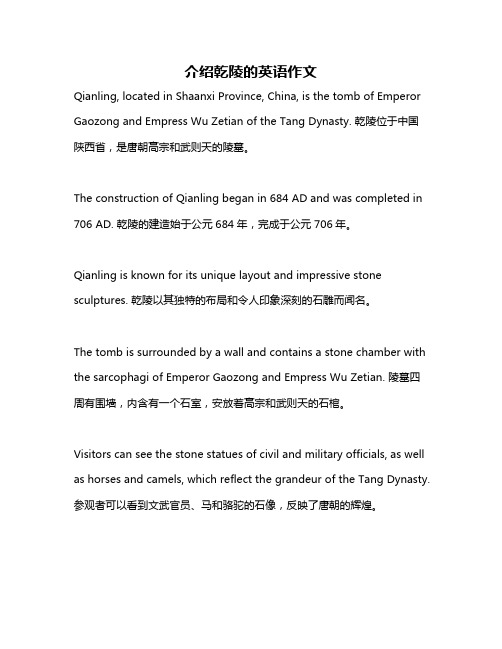
介绍乾陵的英语作文Qianling, located in Shaanxi Province, China, is the tomb of Emperor Gaozong and Empress Wu Zetian of the Tang Dynasty. 乾陵位于中国陕西省,是唐朝高宗和武则天的陵墓。
The construction of Qianling began in 684 AD and was completed in 706 AD. 乾陵的建造始于公元684年,完成于公元706年。
Qianling is known for its unique layout and impressive stone sculptures. 乾陵以其独特的布局和令人印象深刻的石雕而闻名。
The tomb is surrounded by a wall and contains a stone chamber with the sarcophagi of Emperor Gaozong and Empress Wu Zetian. 陵墓四周有围墙,内含有一个石室,安放着高宗和武则天的石棺。
Visitors can see the stone statues of civil and military officials, as well as horses and camels, which reflect the grandeur of the Tang Dynasty. 参观者可以看到文武官员、马和骆驼的石像,反映了唐朝的辉煌。
The tomb of Qianling is also famous for its mural paintings, which depict various scenes from the daily life of the Tang Dynasty. 乾陵的墓室壁画也以描绘唐代日常生活的各种场景而闻名。
游览乾陵的英语作文100词
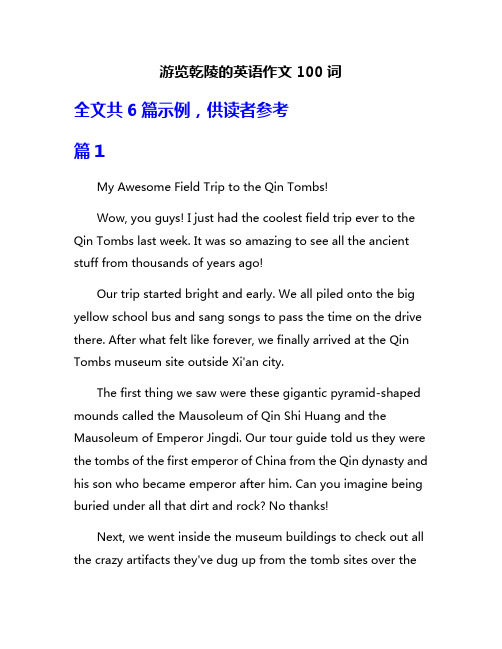
游览乾陵的英语作文100词全文共6篇示例,供读者参考篇1My Awesome Field Trip to the Qin Tombs!Wow, you guys! I just had the coolest field trip ever to the Qin Tombs last week. It was so amazing to see all the ancient stuff from thousands of years ago!Our trip started bright and early. We all piled onto the big yellow school bus and sang songs to pass the time on the drive there. After what felt like forever, we finally arrived at the Qin Tombs museum site outside Xi'an city.The first thing we saw were these gigantic pyramid-shaped mounds called the Mausoleum of Qin Shi Huang and the Mausoleum of Emperor Jingdi. Our tour guide told us they were the tombs of the first emperor of China from the Qin dynasty and his son who became emperor after him. Can you imagine being buried under all that dirt and rock? No thanks!Next, we went inside the museum buildings to check out all the crazy artifacts they've dug up from the tomb sites over theyears. There were tons of pottery soldiers, weapons, jade pieces, and bronze objects on display. My favorite was definitely the life-sized terracotta warriors! They looked so fierce with their painted faces and battle poses. Our guide said they were made to guard the emperor's tomb, which I think is so cool.In another gallery, we saw two amazing bronze chariots that were buried with one of the emperors. They had detailed designs of clouds, dragons, and other mystical creatures all over them. I've never seen anything so intricately decorated before. There were also these mind-blowing miniature models of bureaucrats and buildings that gave us a peek at what life was like back in ancient China.The weirdest thing we learned was that the Qin emperor was obsessed with living forever, so his tomb was loaded with potions and streams of mercury that were supposed to grant him eternal life. Yeah...doesn't sound very safe to me! No wonder they haven't fully excavated his tomb yet after all these centuries.After the museum, we went on a short hike around the tomb mound area. It was pretty hot that day, but seeing all the archeological sites and digging pits made it worth getting a little sweaty. Who knows what other treasures might still be buried underground waiting to be uncovered?All in all, it was such a memorable experience getting to walk in the footsteps of royalty from over 2,000 years ago. I'll never forget the incredible artifacts and learning about the mystical ancient Qin dynasty on this field trip. If you ever get the chance to visit the Qin Tombs near Xi'an, you have to go! It's an adventure back in time that you won't want to miss.篇2Visiting the Qianling MausoleumLast weekend, my family went to visit the Qianling Mausoleum. It's an ancient tomb for emperors from the Tang Dynasty. We walked through the Spirit Path with huge stone statues of warriors, animals, and officials guarding the tomb. The Underground Palace was amazing! It has small rooms carved into the ground displaying figurines of servants, musicians, and animals that were buried with the emperor. My favorite was the kitchen with little clay pots and pans. I felt like I went back in time over 1,300 years! Exploring the mausoleum taught me so much about China's long history and grand emperors.篇3Visiting the Qianling TombWow, what an exciting day I had yesterday! Our class went on a field trip to the Qianling Tomb, which is an amazing ancient tomb complex located outside the city of Xi'an in China. I had been looking forward to this trip for weeks!When we arrived, I was in awe at how huge the site was. The Qianling Tomb covers a massive area of over 200 acres! It was first built as the joint tomb for Emperor Gaozong and Empress Wu Zetian of the Tang Dynasty way back in the 7th century AD. Can you imagine how long ago that was? Over 1,300 years!Our tour guide told us all about the fascinating history of the tomb. Empress Wu Zetian was actually the only female emperor to ever rule China on her own. She was a very powerful and controversial ruler. The construction of her huge tomb showed how important she considered herself to be.After the entrance gate, we walked along the Sacred Way, which is a road lined with huge stone statues of animals and officials. The sculptures were so detailed and intricate. My favorite was the crouching horse sculpture – it looked so lifelike and powerful! Our guide explained that the statues were meant to protect the emperor and empress in the afterlife.Next, we came to a large earthen mound called Baozheng Ling, which was Emperor Gaozong's actual tomb mound. It'sabsolutely gigantic – over 60 meters high! Apparently, hundreds of workers labored for years constructing the immense underground burial chamber beneath the mound. Unfortunately, we couldn't go inside as it remains unexcavated to preserve it.The highlight was definitely Empress Wu Zetian's tomb called Qianling Ling. Her mound is a bit smaller than the emperor's, but inside is a vast and ornate underground tomb complex that took our breath away! The main chamber has beautifully carved stone walls and ceilings with dragons, flowers, and mythical beasts. Archaeologists found many precious artifacts inside like gold crowns, jewelry, statues, and other treasures buried along with the empress.At the end of our tour, we visited the on-site museum that displays some of the most amazing artifacts unearthed from the tombs over the years. I was amazed at the delicately carved nephrite jades, colorful glazed pottery, and glittering gold items. Some objects even had Empress Wu's names and titles carved into them. Holding those ancient relics made me feel connected across the centuries!Overall, I had an absolutely unforgettable experience exploring the grand Qianling Tomb complex. Walking the sacred grounds and visualizing the immense power and riches of thegreat Tang Dynasty rulers was awe-inspiring. I feel so fortunate to have learned so much about this incredible archaeological treasure from China's past. I'll remember this field trip for the rest of my life!篇4A Grand Adventure to the Qianling MausoleumOne sunny Saturday morning, my parents told me we were going on a special trip to see an amazing place called the Qianling Mausoleum. I had never heard of it before, but they said it was the burial site of emperors from a long, long time ago. I was super excited to go on an adventure and learn about history!After a long drive, we finally arrived at the huge entrance gates. They were made of stone and very tall, with fierce stone lion statues guarding the sides. I felt like a tiny ant walking through those massive gates! My mom said they were built during the Tang Dynasty over 1,300 years ago. That's so old, I can't even imagine it.The first thing we saw was the Sacred Way, a long path lined with huge stone statues of warriors, horses, camels and sacred mythical creatures. My dad explained that they were meant to protect the emperor's soul in the afterlife. Some of the statueslooked a bit beaten up from weather over the centuries, but they were still incredibly detailed and life-like. I felt like those stone soldiers were watching me as we walked by!Next, we came upon the Jade Gate, a beautiful arched gate with intricate green glazed decorations. My favorite parts were the ferocious dragon sculptures coiled around the tops. We passed through there into the main area of the mausoleum grounds.In the very center was an enormous earthen mound, over 30 meters tall! This was the royal tomb itself where an emperor was buried deep underground. All around the tomb mound were smaller flat mounds for members of the emperor's family and court. The entire area felt incredibly grand and important.We toured several museum buildings next that displayed artifacts excavated from the tombs - pottery, jewelry, weapons, you name it. There was so much awesome ancient stuff to look at!I was most amazed by the lifesize terracotta horse sculptures. The details of the saddles, reins and even the horses' muscular bodies looked so realistic.One museum had a scale model of the entire mausoleum layout. It was mind-blowing how massive and carefully plannedthe whole complex was constructed. My little legs were getting tired by that point, but I didn't want to miss a single thing.On our way out, we walked through the Mingde Gate, which had more cool stone animal statues lining the path. I tried my best to count them all as we went by. It was hard to imagine how much time and effort went into building this entire place so long ago.In the parking lot, my parents bought me a little souvenir terracotta warrior figure to remember our fun day exploring the Qianling Mausoleum. I couldn't wait to tell my friends at school all about the emperors, stone guardians, and incredible treasures I had seen with my very own eyes. What an awesome adventure!篇5A Magical Day at the Qin MausoleumWow, what an amazing day I had visiting the Qin Mausoleum! It was like stepping into an ancient world of mysteries and wonders. I could hardly believe my eyes when our class took a field trip to this incredible archaeological site.As we walked through the entrance gates, I felt a tingle of excitement rush through me. This was the final resting place ofQin Shi Huang, the famous first emperor of China who united the country over 2,000 years ago! Our guide told us that construction of the mausoleum took over 38 years and required the labor of 700,000 workers. Can you imagine how grand it must have been?The first stop on our tour was the mind-blowing Terracotta Army. Row after row of lifelike soldier statues stood guarding the emperor's tomb. Each one was unique, with different facial features and expressions. Our guide said they were buried with Qin Shi Huang to protect him in the afterlife. As I gazed at the thousands of warriors, horses, and chariots, I felt like I had traveled back in time to an ancient battlefield.Next, we explored some of the outer ruins and earthen pyramids. Climbing the large mounds gave me a panoramic view of the entire complex, which stretches over 22 square miles! Our guide pointed out where archaeologists have excavated offices, stables, and living quarters for the workers who built the mausoleum. I tried to picture what the bustling city surrounding the tomb would have looked like centuries ago.One of the coolest parts was seeing the life-sized terracotta figures of entertainers and acrobats. There were musicians playing flutes and zithers, dancers twirling in flowing robes, andeven a juggler with balls suspended in the air! Qin Shi Huang must have enjoyed quite a lavish lifestyle.Towards the end of our tour, we got to walk through an exhibit hall filled with other incredible artifacts found at the site, like weapons, coins, and jade statues. Seeing the intricate details and craftsmanship was simply mesmerizing. I could have spent hours examining each item!As we headed back to the bus, I felt like my brain was overflowing with all the incredible things I had learned and seen today. The Qin Mausoleum was way more than just an underground tomb - it was an entire microcosm of Qin Dynasty life. Thankfully, this amazing piece of history has been so well preserved for us to experience.I'll never forget the sense of wonder I felt walking those ancient grounds. To me, the Qin Mausoleum was like a magic portal transporting me into the past. I can't wait to go back and explore more archaeological marvels again someday! Today was one for the books.篇6Visiting the Amazing Qianling MausoleumWow, what an incredible trip I had to the Qianling Mausoleum! It was like traveling back in time to the days of ancient China. My class took a field trip there last week, and I'm still in awe over all the amazing things I saw and learned.The Qianling Mausoleum is this gigantic tomb complex way up in the mountains near Xi'an. It's where the emperors and empresses of the Tang Dynasty are buried. Can you believe the Tang Dynasty was over 1,300 years ago? That's SO long ago! The tomb area covers a massive area - over 200 square kilometers! It's made up of tons of different tombs, temples, statues, and other buildings.Our tour guide told us that construction on Qianling started way back in 684 AD during the reign of Emperor Gaozong. It took over 20 years to build using thousands and thousands of workers and craftsmen. Just imagine how much work that must have been without modern construction equipment like bulldozers and cranes! The Tang emperors and empresses who are entombed there ruled over one of the greatest eras in China's history when arts, culture, and trade flourished.The first stop on our tour was the massive Soul Tower. It's a ginormous 36-meter tall tower with intricate stone carvings all over it. Our guide explained that it was used for spiritual Taoistrituals and sacrifices to honor the souls of the deceased emperors and empresses. Walking around the base, I craned my neck trying to see all the details carved at the very top! It felt like the tower pierced the sky.Next we saw the Memorial Gateways and Stele Pavilions. These were basically grand entryways with ornate stone archways, pillars, and inscribed monuments commemorating the Qianling royalty buried there. Some of the calligraphy was so stylized and intricate, almost like modern art! I tried my best to decipher the inscriptions but they used such poetic language.Then it was on to the actual underground tombs themselves - my favorite part! We first visited the Tombs of Emperor Zhongzong and Empress Wu Zetian. Let me tell you, their tomb area was MASSIVE spanning over 20,000 square meters! The entrance alone had these massive stone mythological animal statues lining the path, like lions, camels, and xiezhi unicorn creatures. So cool!Once inside the tomb area, there were rooms and chambers for every purpose - ceremonial rooms, treasuries, corridors, even living quarters for servants and staff who literally lived their entire lives there maintaining the tombs. Our guide showed us placards explaining how the tombs were specially constructedusing precise design and cosmic principles to allow the spirit of the emperor safe passage to the afterlife. Mind-blowing stuff!My absolute favorite was seeing the life-sized terracotta figurines - hundreds of them! There were civilian figures, horsemen, guardians, you name it. Many were exquisitely painted with bright colors and fine details like you'd never imagine could last nearly 1,500 years. The craftsmanship was simply incredible. My classmates and I felt like we'd uncovered a whole underground civilization frozen in time.After the intense tomb areas, we got to explore some of the other buildings like the Leixing Pavilion where special ceremonies were conducted. The roof had these vibrant glazed roof tiles in yellow, green, and sapphire blue hues. So beautiful! Our guide taught us about the spiritual rites and offerings made there to help guide the souls to their resting place.As we walked the grounds, every corner revealed something new - rockeries, gardens, decorations, tablets and steles with profound writings about life and the universe. It was equal parts fascinating history lesson and jaw-dropping archaeological marvel. I hardly knew which way to look!My brain was just bursting with all the new information about Tang culture, architecture, spirituality, craftsmanship, andaccomplishments. The Qianling Mausoleum was like a living museum showcasing the grandest aspects of one of China's most celebrated dynasties. I have such a deeper appreciation now for the math, science, philosophy, and artistry that went into creating this eternal resting place for royalty.I'm so grateful my school organized this trip. It really brought my ancient history studies to life in a way no textbook could. Simply seeing the immensity, details, andbeauty of Qianling with my own eyes was an experience I'll never forget. Who knew learning could be so awesome and fun? I can't wait to go back someday when I'm older to uncover even more of its mysteries and wonders. The Qianling Mausoleum is an absolute must-see!。
乾陵相关英文作文

乾陵相关英文作文下载温馨提示:该文档是我店铺精心编制而成,希望大家下载以后,能够帮助大家解决实际的问题。
文档下载后可定制随意修改,请根据实际需要进行相应的调整和使用,谢谢!并且,本店铺为大家提供各种各样类型的实用资料,如教育随笔、日记赏析、句子摘抄、古诗大全、经典美文、话题作文、工作总结、词语解析、文案摘录、其他资料等等,如想了解不同资料格式和写法,敬请关注!Download tips: This document is carefully compiled by theeditor. I hope that after you download them,they can help yousolve practical problems. The document can be customized andmodified after downloading,please adjust and use it according toactual needs, thank you!In addition, our shop provides you with various types ofpractical materials,such as educational essays, diaryappreciation,sentence excerpts,ancient poems,classic articles,topic composition,work summary,word parsing,copyexcerpts,other materials and so on,want to know different data formats andwriting methods,please pay attention!The Qianling Mausoleum is really amazing. It has a long history and many stories. There are so many things to discover there.You can see the grandeur of the mausoleum. The architecture is so unique and beautiful. It makes you feel the wisdom and creativity of the ancients.Lots of tourists come to visit Qianling. They are all attracted by its charm. It's like a mysterious place that makes people curious.The scenery around Qianling is also very nice. It adds to the atmosphere of the place. You can enjoy the view while exploring.。
关于陕西乾陵的英语作文
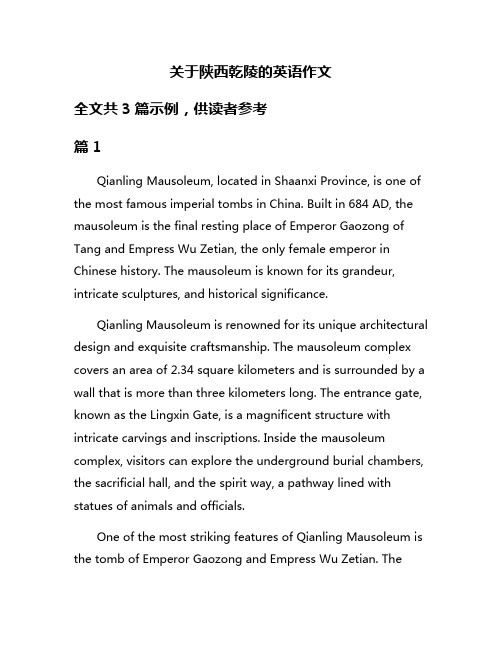
关于陕西乾陵的英语作文全文共3篇示例,供读者参考篇1Qianling Mausoleum, located in Shaanxi Province, is one of the most famous imperial tombs in China. Built in 684 AD, the mausoleum is the final resting place of Emperor Gaozong of Tang and Empress Wu Zetian, the only female emperor in Chinese history. The mausoleum is known for its grandeur, intricate sculptures, and historical significance.Qianling Mausoleum is renowned for its unique architectural design and exquisite craftsmanship. The mausoleum complex covers an area of 2.34 square kilometers and is surrounded by a wall that is more than three kilometers long. The entrance gate, known as the Lingxin Gate, is a magnificent structure with intricate carvings and inscriptions. Inside the mausoleum complex, visitors can explore the underground burial chambers, the sacrificial hall, and the spirit way, a pathway lined with statues of animals and officials.One of the most striking features of Qianling Mausoleum is the tomb of Emperor Gaozong and Empress Wu Zetian. Thetomb is located at the center of the mausoleum complex and is surrounded by a number of smaller satellite tombs. The tomb itself is a massive underground structure, with a series of chambers and corridors that lead to the burial chamber. The burial chamber is adorned with intricate murals, sculptures, and inscriptions that depict scenes from the lives of the emperor and empress.In addition to its architectural splendor, Qianling Mausoleum also holds great historical significance. Empress Wu Zetian, who is buried in the mausoleum, was a controversial figure in Chinese history. She rose to power as the empress consort of Emperor Gaozong and eventually became the only female emperor in Chinese history. Her reign was marked by political intrigue, military conquests, and cultural achievements. The mausoleum serves as a testament to her legacy and the power and influence she wielded during her lifetime.Overall, Qianling Mausoleum is a remarkable historical site that offers visitors a glimpse into the grandeur and complexity of the Tang Dynasty. Its architectural beauty, historical significance, and cultural importance make it a must-visit destination for anyone interested in Chinese history and culture. Whether you are a history enthusiast, a cultural explorer, or simply a curioustraveler, a visit to Qianling Mausoleum is sure to leave a lasting impression.篇2The Qianling Mausoleum, located on Liangshan Mountain in Shaanxi Province, is one of the most famous and well-preserved imperial tombs in China. Built during the Tang Dynasty (618-907 AD), it holds the remains of Emperor Gaozong and Empress Wu Zetian, the only female emperor in Chinese history.The Qianling Mausoleum covers an area of over 200 square kilometers and is surrounded by a perimeter wall. The mausoleum complex is divided into three main sections: the main tomb, the northern and southern burial pits, and the surrounding tombs of various officials and members of the royal family.The main tomb, which is the largest and most well-preserved structure in the complex, is where Emperor Gaozong and Empress Wu Zetian are buried. The tomb is built in the shape of a pyramid, with a square base and four sloping sides. It is believed to be filled with precious treasures and artifacts that were buried with the emperor and empress to accompany them in the afterlife.The northern and southern burial pits contain the remains of soldiers and horses that were buried alive with the emperor and empress to serve them in the afterlife. These pits are filled with life-sized statues of soldiers and horses, as well as weapons and armor that were used during the Tang Dynasty.Surrounding the main tomb are the tombs of various officials and members of the royal family, including the tombs of the emperor's concubines and attendants. These tombs are smaller in size but are also richly decorated with carvings and paintings that depict scenes from daily life during the Tang Dynasty.The Qianling Mausoleum is not only a burial site but also a historical and cultural treasure that provides valuable insights into the traditions and beliefs of the Tang Dynasty. It is a testament to the power and influence of Emperor Gaozong and Empress Wu Zetian, as well as the artistry and craftsmanship of the craftsmen and artisans who built the mausoleum.Today, the Qianling Mausoleum is a popular tourist destination that attracts visitors from all over the world. Its impressive architecture, beautiful surroundings, and rich history make it a must-see attraction for anyone interested in Chinese culture and heritage. A visit to the Qianling Mausoleum is ajourney back in time to the glorious days of the Tang Dynasty, when China was a great empire ruled by powerful emperors and empresses.篇3The Qianling Mausoleum, located on Liangshan Hill in Shaanxi Province, China, is the resting place of Emperor Gaozong and Empress Wu Zetian of the Tang Dynasty. Built in 684 AD, the mausoleum is one of the most well-preserved ancient tombs in China and a UNESCO World Heritage Site.The Qianling Mausoleum covers an area of over 3 square kilometers and is surrounded by walls with a perimeter of 2720 meters. The mausoleum complex consists of the main tomb, subsidiary tombs, sacrificial pits, and a museum. The main tomb is where Emperor Gaozong and Empress Wu Zetian are buried, while the subsidiary tombs house the remains of other members of the imperial family.One of the most impressive features of the Qianling Mausoleum is the 17-meter-tall stone stele known as the Qianling Stele, which stands in front of the tomb. The stele is decorated with intricate carvings of dragons, phoenixes, andother mythical creatures, as well as inscriptions detailing the accomplishments of Emperor Gaozong and Empress Wu Zetian.The Qianling Mausoleum is also famous for its stunning array of Tang Dynasty murals, which adorn the walls of the tomb chambers. These murals depict scenes of daily life, religious rituals, and court ceremonies, providing valuable insights into the culture and customs of the Tang Dynasty.In addition to its historical and cultural significance, the Qianling Mausoleum is a popular tourist attraction, drawing visitors from all over the world. The serene beauty of the surrounding landscape, with its lush forests and rolling hills, makes it a peaceful and tranquil place to visit.Overall, the Qianling Mausoleum is a remarkable testament to the rich history and cultural heritage of China. Its grandeur and beauty continue to captivate visitors and scholars alike, offering a glimpse into the magnificent world of the Tang Dynasty.。
用说明顺序来介绍乾陵600字的作文
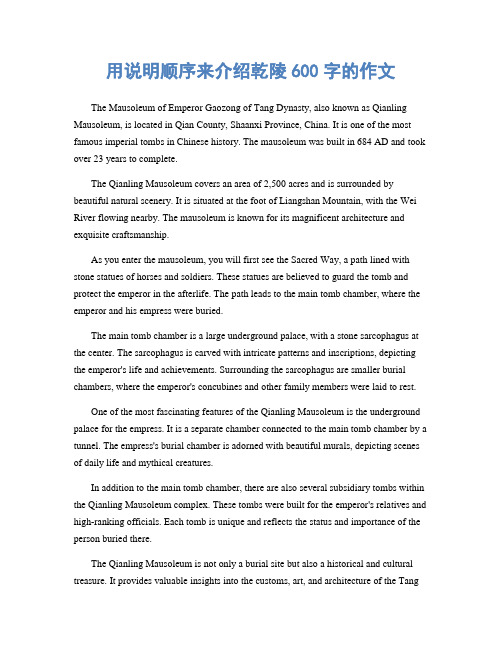
用说明顺序来介绍乾陵600字的作文The Mausoleum of Emperor Gaozong of Tang Dynasty, also known as Qianling Mausoleum, is located in Qian County, Shaanxi Province, China. It is one of the most famous imperial tombs in Chinese history. The mausoleum was built in 684 AD and took over 23 years to complete.The Qianling Mausoleum covers an area of 2,500 acres and is surrounded by beautiful natural scenery. It is situated at the foot of Liangshan Mountain, with the Wei River flowing nearby. The mausoleum is known for its magnificent architecture and exquisite craftsmanship.As you enter the mausoleum, you will first see the Sacred Way, a path lined with stone statues of horses and soldiers. These statues are believed to guard the tomb and protect the emperor in the afterlife. The path leads to the main tomb chamber, where the emperor and his empress were buried.The main tomb chamber is a large underground palace, with a stone sarcophagus at the center. The sarcophagus is carved with intricate patterns and inscriptions, depicting the emperor's life and achievements. Surrounding the sarcophagus are smaller burial chambers, where the emperor's concubines and other family members were laid to rest.One of the most fascinating features of the Qianling Mausoleum is the underground palace for the empress. It is a separate chamber connected to the main tomb chamber by a tunnel. The empress's burial chamber is adorned with beautiful murals, depicting scenes of daily life and mythical creatures.In addition to the main tomb chamber, there are also several subsidiary tombs within the Qianling Mausoleum complex. These tombs were built for the emperor's relatives and high-ranking officials. Each tomb is unique and reflects the status and importance of the person buried there.The Qianling Mausoleum is not only a burial site but also a historical and cultural treasure. It provides valuable insights into the customs, art, and architecture of the TangDynasty. It is a testament to the grandeur and sophistication of ancient Chinese civilization.Overall, the Qianling Mausoleum is a remarkable historical site that showcases the rich heritage of the Tang Dynasty. Its grand architecture, intricate craftsmanship, and beautiful surroundings make it a must-visit destination for history and culture enthusiasts.唐高宗李治的陵墓,也被称为乾陵,位于中国陕西省乾县。
关于陕西乾陵的英语作文
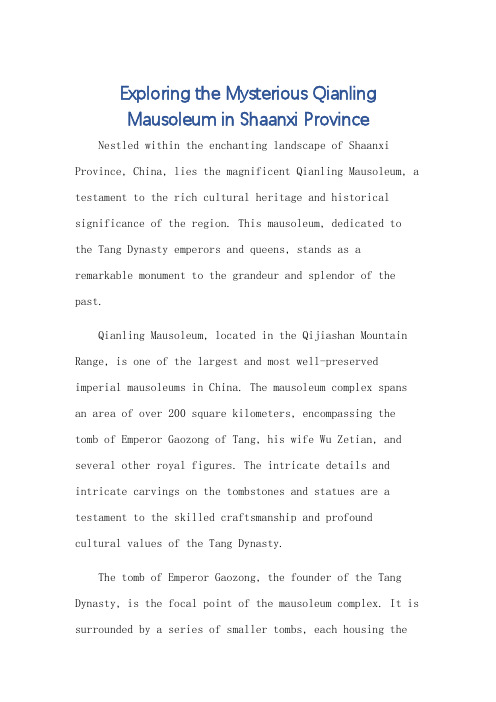
Exploring the Mysterious QianlingMausoleum in Shaanxi ProvinceNestled within the enchanting landscape of Shaanxi Province, China, lies the magnificent Qianling Mausoleum, a testament to the rich cultural heritage and historical significance of the region. This mausoleum, dedicated to the Tang Dynasty emperors and queens, stands as a remarkable monument to the grandeur and splendor of the past.Qianling Mausoleum, located in the Qijiashan Mountain Range, is one of the largest and most well-preserved imperial mausoleums in China. The mausoleum complex spans an area of over 200 square kilometers, encompassing the tomb of Emperor Gaozong of Tang, his wife Wu Zetian, and several other royal figures. The intricate details and intricate carvings on the tombstones and statues are a testament to the skilled craftsmanship and profoundcultural values of the Tang Dynasty.The tomb of Emperor Gaozong, the founder of the Tang Dynasty, is the focal point of the mausoleum complex. It is surrounded by a series of smaller tombs, each housing theremains of royal family members and high-ranking officials. The tombstones, with their intricate carvings and rich historical inscriptions, offer a glimpse into the lives and accomplishments of these individuals.One of the most remarkable features of Qianling Mausoleum is the scale and grandeur of its architecture. The tombstones are enormous, some weighing several tons, and are adorned with intricate carvings depicting scenes from the life of Emperor Gaozong and his queens. The statues, ranging from life-sized figures to minute details, exhibit remarkable skill and attention to detail.The mausoleum is also famous for its unique landscape, which combines natural beauty with man-made grandeur. The surrounding mountains and valleys provide a serene and peaceful backdrop to the tombstones and statues, creating an atmosphere of tranquility and respect.Qianling Mausoleum is not just a place of historical significance; it is also a vibrant cultural hub. The area surrounding the mausoleum is home to numerous cultural relics and historical sites, including temples, pagodas, and ancient villages. Visitors can explore these sites,learn about the rich history and culture of the Tang Dynasty, and appreciate the beauty and craftsmanship of the ancient mausoleum.In conclusion, Qianling Mausoleum is a remarkable testament to the rich cultural heritage and historical significance of Shaanxi Province. It offers a unique opportunity to explore the grandeur and splendor of the Tang Dynasty, appreciate the skilled craftsmanship of ancient artisans, and immerse oneself in the beauty and serenity of the surrounding landscape. Visiting Qianling Mausoleum is an unforgettable experience that will leave a lasting impression on anyone who ventures into its神秘的世界。
介绍乾陵的英语作文
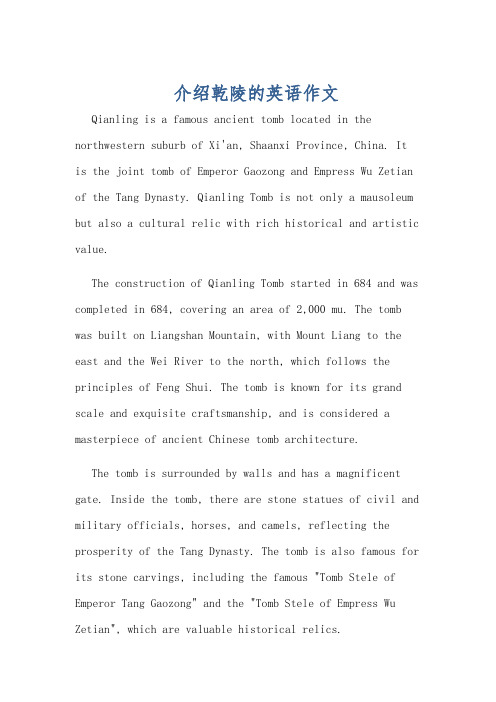
介绍乾陵的英语作文Qianling is a famous ancient tomb located in the northwestern suburb of Xi'an, Shaanxi Province, China. Itis the joint tomb of Emperor Gaozong and Empress Wu Zetian of the Tang Dynasty. Qianling Tomb is not only a mausoleum but also a cultural relic with rich historical and artistic value.The construction of Qianling Tomb started in 684 and was completed in 684, covering an area of 2,000 mu. The tomb was built on Liangshan Mountain, with Mount Liang to the east and the Wei River to the north, which follows the principles of Feng Shui. The tomb is known for its grand scale and exquisite craftsmanship, and is considered a masterpiece of ancient Chinese tomb architecture.The tomb is surrounded by walls and has a magnificent gate. Inside the tomb, there are stone statues of civil and military officials, horses, and camels, reflecting the prosperity of the Tang Dynasty. The tomb is also famous for its stone carvings, including the famous "Tomb Stele of Emperor Tang Gaozong" and the "Tomb Stele of Empress Wu Zetian", which are valuable historical relics.Qianling Tomb is not only a historical site but also a scenic spot. The area around the tomb is covered with beautiful scenery, including lush trees, clear streams, and ancient cypresses. It is a popular destination for tourists to learn about Chinese history and appreciate the beauty of nature.乾陵是中国陕西省西安市西北郊的一座著名古墓,是唐朝高宗李治和武则天的合葬墓。
乾陵博物院英文导游词

The Qianling MausoleumLadies and gentlemen, welcome to the Qianling Mausoleum. Today l will introduce you to the unique mausoleum. Because it is the only mausoleum in China in which is buried two emperors, and there is the only female emperor in Chinese history.The Qianling Mausoleum lies in the Liangshan Hill about 80 kilometers northwest of the city of Xi’an. It belongs to the 3rd emperor of Tang dynasty, Li Zhi, who was later known as Gao Zong, and his empress, Wu Zetian.Now let’s look at the three hills. What do you think is they like? Yes. The folk call the tw o peaks “Nipple Hills”.Ok this way please. We are going thought the holy way. On both of the holy way in front of the tomb, 124 exquisite and lively stone statues are lined up-a pair of cloud pillars, a pair of flying horses, and ten pairs of guarding. They were built to protect the emperor’s tomb.Outside the south gate there are tw o tablets: The tablet to Holy Deeds of Emperor Gao Zong and The Wordless Tablet to Wu Zetian. I suppose you a re interesting the female emperor. Wu Zetian ‘s name was Zhao. She was chosen as Cai Ren by the second emperor of the Tang dynasty, Tai Zong, at the age of 14. She was sent to a temple to be a nun when Emperor Tai Zong died. She was then only 26. Three years later the third emperor of the Tang dynasty, Gao Zong, called her to come back to the Palace as his concubine. Wu Zetian was a very intelligent woman and became so pow erful that she helped Emperor Gao Zong govern the court. When she was almost 60 years old, her husband, Emperor Gao Zong, died. She became the Emperor at the age of 66. She changed the Tang dynasty into the Zhou dynasty and so became the only female emperor in Chinese history. This dragon lady died at the age 82 and was buried in Qianling Mausoleum with her husband.Now we have arrived at the behind of the Wordless Tablet. It is 6.3 meters high. Why was a w ordless tablet set up for Emperor Wu Zetian? Some say that she was the first female emperor and her accomplishment was immeasurable and beyond w ords. Others say that she w anted the people of later generations to give her a just and fair appraisal. Still some others think that it was probably set up by Emperor Zhong Zong, who wasdissatisfied with her arbitrary decisions and peremptory act ions and unwilling to flatter her. But as her son, it was inappropriate for him to reproach her. So he set urap the wordless tablet to let people of later generations appraise her. Anyway, such a tablet has not been found before any other imperial mausoleums in our country.Let’s look at the other tablet- The tablet to Holy Deeds of Emperor Gao Zong. It consists of seven joints, so it is called the Seven-joint Tablet. The ancient Chinese believed that the universe was composed of seven elements-the sun, the moon, metal, wood water, fire and earth. The inscription on the tablet was composed by Wu Zetian and written by Emperor Zhong Zong. It contains over 8,000 characters, singing the praises of Emperor Gao Zong’s political achievements and military exploits. As w e know, the Seven-joint Tablet was the first one of all tablets in emperor’s mausoleums.Beyond the tw o tablets there are 61 stone statues standing in two groups. In order to commemorate the heads of the Chinese ethnic minorities and the envoys from foreign countries that attended Emperor Gao Zong’s funeral. Unfortunately all but tw o of the characters are already undecipherable.Besides there are three famous satellite tombs of Qianling Mausoleum-the tomb of Princess Yong Tai, the tomb of Crown Prince Zhang Huai and the tomb of Crown Prince Yi De. A lot of murals were discovered. They can be regarded as masterpieces of painting from Tang dynasty.Ladies and gentlemen: I hope you have enjoyed my introduction to The Qianling Mausoleum. Have a pleasant trip! See you!。
陕西八大景点导游词(中英文史上最全版)
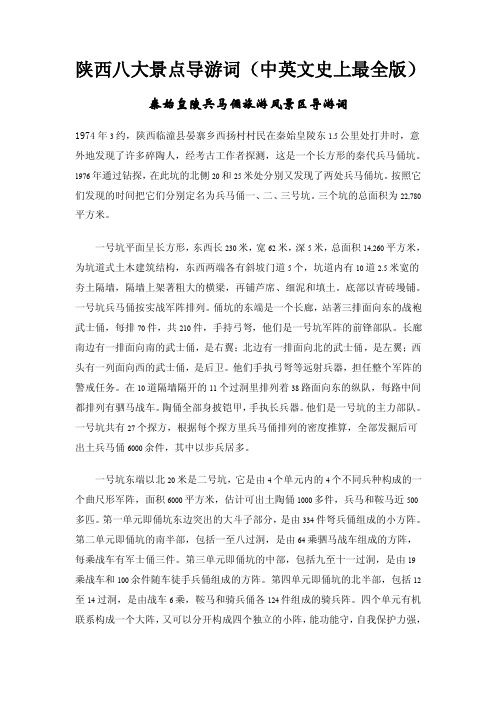
陕西八大景点导游词(中英文史上最全版)秦始皇陵兵马俑旅游风景区导游词1974年3约,陕西临潼县晏寨乡西扬村村民在秦始皇陵东1.5公里处打井时,意外地发现了许多碎陶人,经考古工作者探测,这是一个长方形的秦代兵马俑坑。
1976年通过钻探,在此坑的北侧20和25米处分别又发现了两处兵马俑坑。
按照它们发现的时间把它们分别定名为兵马俑一、二、三号坑。
三个坑的总面积为22,780平方米。
一号坑平面呈长方形,东西长230米,宽62米,深5米,总面积14,260平方米,为坑道式土木建筑结构,东西两端各有斜坡门道5个,坑道内有10道2.5米宽的夯土隔墙,隔墙上架著粗大的横梁,再铺芦席、细泥和填土。
底部以青砖墁铺。
一号坑兵马俑按实战军阵排列。
俑坑的东端是一个长廊,站著三排面向东的战袍武士俑,每排70件,共210件,手持弓弩,他们是一号坑军阵的前锋部队。
长廊南边有一排面向南的武士俑,是右翼;北边有一排面向北的武士俑,是左翼;西头有一列面向西的武士俑,是后卫。
他们手执弓弩等远射兵器,担任整个军阵的警戒任务。
在10道隔墙隔开的11个过洞里排列着38路面向东的纵队,每路中间都排列有驷马战车。
陶俑全部身披铠甲,手执长兵器。
他们是一号坑的主力部队。
一号坑共有27个探方,根据每个探方里兵马俑排列的密度推算,全部发掘后可出土兵马俑6000余件,其中以步兵居多。
一号坑东端以北20米是二号坑,它是由4个单元内的4个不同兵种构成的一个曲尺形军阵,面积6000平方米,估计可出土陶俑1000多件,兵马和鞍马近500多匹。
第一单元即俑坑东边突出的大斗子部分,是由334件弩兵俑组成的小方阵。
第二单元即俑坑的南半部,包括一至八过洞,是由64乘驷马战车组成的方阵,每乘战车有军士俑三件。
第三单元即俑坑的中部,包括九至十一过洞,是由19乘战车和100余件随车徒手兵俑组成的方阵。
第四单元即俑坑的北半部,包括12至14过洞,是由战车6乘,鞍马和骑兵俑各124件组成的骑兵阵。
乾陵英文导游词
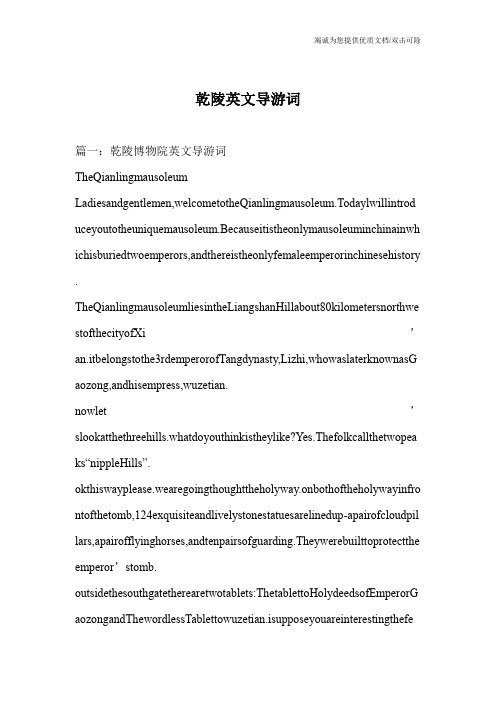
乾陵英文导游词篇一:乾陵博物院英文导游词TheQianlingmausoleumLadiesandgentlemen,welcometotheQianlingmausoleum.Todaylwillintrod uceyoutotheuniquemausoleum.Becauseitistheonlymausoleuminchinainwh ichisburiedtwoemperors,andthereistheonlyfemaleemperorinchinesehistory .TheQianlingmausoleumliesintheLiangshanHillabout80kilometersnorthwe stofthecityofXi’an.itbelongstothe3rdemperorofTangdynasty,Lizhi,whowaslaterknownasG aozong,andhisempress,wuzetian.nowlet’slookatthethreehills.whatdoyouthinkistheylike?Yes.Thefolkcallthetwopea ks“nippleHills”.okthiswayplease.wearegoingthoughttheholyway.onbothoftheholywayinfro ntofthetomb,124exquisiteandlivelystonestatuesarelinedup-apairofcloudpil lars,apairofflyinghorses,andtenpairsofguarding.Theywerebuilttoprotectthe emperor’stomb.outsidethesouthgatetherearetwotablets:ThetablettoHolydeedsofEmperorG aozongandThewordlessTablettowuzetian.isupposeyouareinterestingthefemaleemperor.wuzetian‘snamewaszhao.ShewaschosenascaiRenbythesecondemperoroftheTangd ynasty,Taizong,attheageof14.ShewassenttoatempletobeanunwhenEmperor Taizongdied.Shewasthenonly26.ThreeyearslaterthethirdemperoroftheTan gdynasty,Gaozong,calledhertocomebacktothePalaceashisconcubine.wuzet ianwasaveryintelligentwomanandbecamesopowerfulthatshehelpedEmpero rGaozonggovernthecourt.whenshewasalmost60yearsold,herhusband,Emp erorGaozong,died.ShebecametheEmperorattheageof66.ShechangedtheTa ngdynastyintothezhoudynastyandsobecametheonlyfemaleemperorinchine sehistory.Thisdragonladydiedattheage82andwasburiedinQianlingmausole umwithherhusband. nowwehavearrivedatthebehindofthewordlessTablet.itis6.3metershigh.why wasawordlesstabletsetupforEmperorwuzetian?Somesaythatshewasthefirst femaleemperorandheraccomplishmentwasimmeasurableandbeyondwords. otherssaythatshewantedthepeopleoflatergenerationstogiveherajustandfaira ppraisal.StillsomeothersthinkthatitwasprobablysetupbyEmperorzhongzon g,whowas dissatisfiedwithherarbitrarydecisionsandperemptoryactionsandunwillingto flatterher.Butasherson,itwasinappropriateforhimtoreproachher.Sohesetura pthewordlesstablettoletpeopleoflatergenerationsappraiseher.anyway,sucha tablethasnotbeenfoundbeforeanyotherimperialmausoleumsinourcountry. Let’slookattheothertablet-ThetablettoHolydeedsofEmperorGaozong.itconsists ofsevenjoints,soitiscalledtheSeven-jointTablet.Theancientchinesebelieved thattheuniversewascomposedofsevenelements-thesun,themoon,metal,woo dwater,fireandearth.Theinscriptiononthetabletwascomposedbywuzetianan dwrittenbyEmperorzhongzong.itcontainsover8,000characters,singingthep raisesofEmperorGaozong’spoliticalachievementsandmilitaryexploits.asweknow,theSeven-jointTable twasthefirstoneofalltabletsinemperor’smausoleums. Beyondthetwotabletsthereare61stonestatuesstandingintwogroups.inordert ocommemoratetheheadsofthechineseethnicminoritiesandtheenvoysfromfo reigncountriesthatattendedEmperorGaozong’sfuneral.Unfortunatelyallbuttwoofthecharactersarealreadyundecipherable. BesidestherearethreefamoussatellitetombsofQianlingmausoleum-thetomb ofPrincessYongTai,thetombofcrownPrincezhangHuaiandthetombofcrown PrinceYide.alotofmuralswerediscovered.Theycanberegardedasmasterpiec esofpaintingfromTangdynasty.Ladiesandgentlemen:ihopeyouhaveenjoyedmyintroductiontoTheQianling mausoleum.Haveapleasanttrip!Seeyou!篇二:乾陵导游词女士们、先生们大家好!今天我将带领大家游览唐代帝王陵墓之冠-乾陵。
介绍乾陵英语作文80词

介绍乾陵英语作文80词English: Located in the eastern suburbs of Xi'an, Qianling Mausoleum is a famous imperial tomb that belongs to the Tang Dynasty. It was built in 684 AD for Emperor Gaozong and Empress Wu Zetian. The tomb's layout is unique, with a rectangular outer city and a circular inner city. The mausoleum is surrounded by undulating mountains, creating a serene and picturesque setting. The main tomb chamber contains the sarcophagi of the emperor and empress, along with exquisite cultural relics, such as funerary objects and stone sculptures. Qianling Mausoleum is not only an important historical site but also a popular tourist destination, attracting visitors from all over the world to marvel at its beauty and learn about the rich Tang Dynasty history.中文翻译: 乾陵位于西安东郊,是属于唐代的一座著名帝陵。
它建于公元684年,为唐高宗李治和武则天所建。
The Qianling Mausoleum
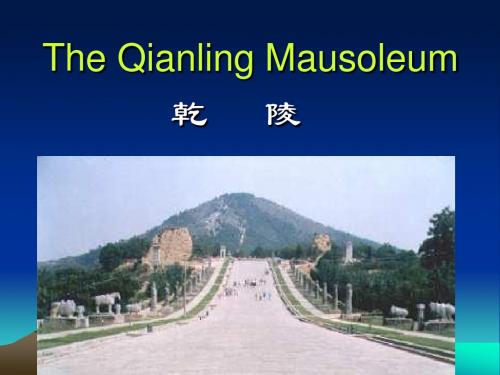
她14岁被唐太宗选人宫为才人,封为“才 岁被唐太宗选人宫为才人, 岁被唐太宗选人宫为才人 封为“ 人”。太宗死后和其他宫女被迫入感业寺削 发为尼,这时她年仅26岁 发为尼,这时她年仅 岁。 When she was 14, she was chosen and admitted into the imperial palace (皇宫) 皇宫) and was conferred the title “cairen”. After Tai zong’s death, Wu Zetian and the other palace maids(宫女) were forced (宫女) to become nuns(尼) in Ganye Temple. ( She was only 26 then.
The Qianling Mausoleum was built in 684 A.D., and brought into completion 23 years later. The Qianling Mausoleum is located on Liangshan Mountain, 6 kilometers north of Qianxian County and 76 kilometers from Xi'an.
20
【述圣记碑】 述圣记碑】 SevenSevensection Stele
21
【述圣记碑】 述圣记碑】 SevenSeven-section Stele
22
【述圣记碑】 述圣记碑】 SevenSeven-section Stele
23
【述圣记碑】 述圣记碑】 SevenSeven-section Stele
11
之后,武则天用酒毒死长子,废次子为庶人,把 之后,武则天用酒毒死长子,废次子为庶人, 睿宗拉下皇位,最终于公元690 690年 自称圣神皇帝, 睿宗拉下皇位,最终于公元690年,自称圣神皇帝, 改国号为周。经过36年的奋斗,终于如愿以偿, 36年的奋斗 改国号为周。经过36年的奋斗,终于如愿以偿, 登上天下第一把“交椅” 登上天下第一把“交椅”,成为中国历史上惟一 的女皇。 的女皇。 Through 36 years of struggle , she finally ascended the throne and became the only empress in Chinese history.
游乾陵英语作文
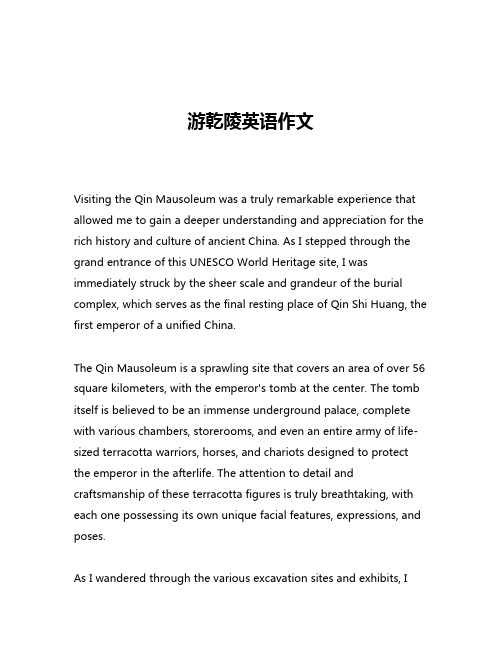
游乾陵英语作文Visiting the Qin Mausoleum was a truly remarkable experience that allowed me to gain a deeper understanding and appreciation for the rich history and culture of ancient China. As I stepped through the grand entrance of this UNESCO World Heritage site, I was immediately struck by the sheer scale and grandeur of the burial complex, which serves as the final resting place of Qin Shi Huang, the first emperor of a unified China.The Qin Mausoleum is a sprawling site that covers an area of over 56 square kilometers, with the emperor's tomb at the center. The tomb itself is believed to be an immense underground palace, complete with various chambers, storerooms, and even an entire army of life-sized terracotta warriors, horses, and chariots designed to protect the emperor in the afterlife. The attention to detail and craftsmanship of these terracotta figures is truly breathtaking, with each one possessing its own unique facial features, expressions, and poses.As I wandered through the various excavation sites and exhibits, Iwas struck by the sheer ingenuity and ambition of the Qin dynasty. The engineering feats required to construct this vast underground city, complete with intricate drainage systems, defensive walls, and a complex network of roads and pathways, are truly awe-inspiring. The level of organization and coordination required to oversee the creation of such a massive and intricate project is a testament to the power and influence of the Qin dynasty.One of the most fascinating aspects of the Qin Mausoleum was the way in which it provided a window into the beliefs and values of ancient Chinese society. The inclusion of the terracotta warriors, as well as various other artifacts and treasures, suggests a deep-seated belief in the afterlife and the importance of providing for the deceased in the next world. The attention to detail and the sheer scale of the project also speaks to the importance of legacy and the desire to be remembered long after one's death.As I explored the various exhibits and displays, I was struck by the sense of reverence and respect that permeated the site. The Qin Mausoleum is not simply a historical relic, but a living, breathing testament to the enduring power and influence of ancient Chinese culture. The site is a testament to the ingenuity, ambition, and cultural richness of the Qin dynasty, and it serves as a powerful reminder of the enduring legacy of ancient China.One of the most striking aspects of the Qin Mausoleum was the way in which it challenged my preconceptions about ancient Chinese history. While I had always been aware of the Qin dynasty and its importance in the unification of China, I had never fully grasped the scale and complexity of the Qin Mausoleum. The sheer size and scope of the site, as well as the level of detail and craftsmanship evident in the terracotta figures and other artifacts, was truly breathtaking.As I wandered through the various exhibits and displays, I was struck by the sense of awe and wonder that permeated the site. The Qin Mausoleum is not simply a relic of the past, but a living, breathing testament to the enduring power and influence of ancient Chinese culture. The site is a testament to the ingenuity, ambition, and cultural richness of the Qin dynasty, and it serves as a powerful reminder of the enduring legacy of ancient China.One of the most powerful aspects of the Qin Mausoleum was the way in which it challenged my preconceptions about ancient Chinese history. While I had always been aware of the Qin dynasty and its importance in the unification of China, I had never fully grasped the scale and complexity of the Qin Mausoleum. The sheer size and scope of the site, as well as the level of detail and craftsmanship evident in the terracotta figures and other artifacts, was truly breathtaking.As I explored the various exhibits and displays, I was struck by the sense of reverence and respect that permeated the site. The Qin Mausoleum is not simply a historical relic, but a living, breathing testament to the enduring power and influence of ancient Chinese culture. The site is a testament to the ingenuity, ambition, and cultural richness of the Qin dynasty, and it serves as a powerful reminder of the enduring legacy of ancient China.Overall, my visit to the Qin Mausoleum was a truly transformative experience that has left a lasting impression on me. The sheer scale and complexity of the site, combined with the level of detail and craftsmanship evident in the various artifacts and exhibits, has deepened my appreciation and understanding of ancient Chinese history and culture. The Qin Mausoleum is a remarkable testament to the enduring power and influence of ancient China, and it serves as a powerful reminder of the rich and diverse cultural heritage that continues to shape our world today.。
写乾陵的作文300字
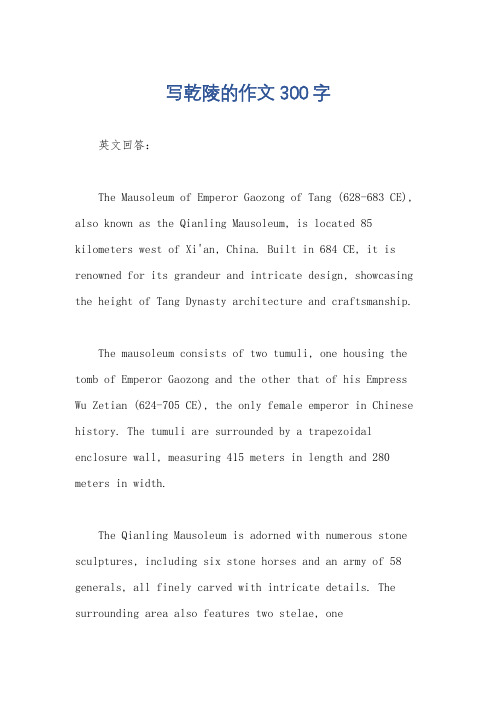
写乾陵的作文300字英文回答:The Mausoleum of Emperor Gaozong of Tang (628-683 CE), also known as the Qianling Mausoleum, is located 85 kilometers west of Xi'an, China. Built in 684 CE, it is renowned for its grandeur and intricate design, showcasing the height of Tang Dynasty architecture and craftsmanship.The mausoleum consists of two tumuli, one housing the tomb of Emperor Gaozong and the other that of his Empress Wu Zetian (624-705 CE), the only female emperor in Chinese history. The tumuli are surrounded by a trapezoidal enclosure wall, measuring 415 meters in length and 280 meters in width.The Qianling Mausoleum is adorned with numerous stone sculptures, including six stone horses and an army of 58 generals, all finely carved with intricate details. The surrounding area also features two stelae, onecommemorating the achievements of Emperor Gaozong and the other Empress Wu Zetian.In addition to its architectural significance, the Qianling Mausoleum is also a treasure trove of historical artifacts. The discovery of a large number of precious relics, such as ceramics, gold and silver objects, andother funeral goods, has shed light on the grandeur of the Tang Dynasty and the burial customs of the period.中文回答:乾陵,又称唐高宗乾陵,位于中国西安市西85公里处。
描写乾陵的英语作文
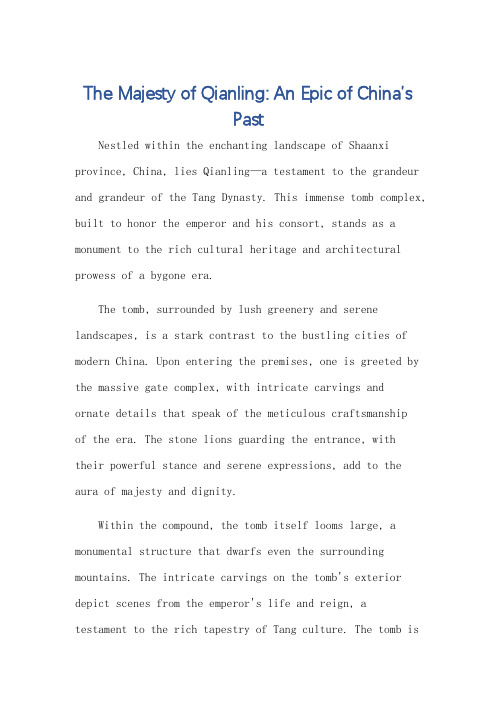
The Majesty of Qianling: An Epic of China'sPastNestled within the enchanting landscape of Shaanxi province, China, lies Qianling—a testament to the grandeur and grandeur of the Tang Dynasty. This immense tomb complex, built to honor the emperor and his consort, stands as a monument to the rich cultural heritage and architectural prowess of a bygone era.The tomb, surrounded by lush greenery and serene landscapes, is a stark contrast to the bustling cities of modern China. Upon entering the premises, one is greeted by the massive gate complex, with intricate carvings andornate details that speak of the meticulous craftsmanshipof the era. The stone lions guarding the entrance, withtheir powerful stance and serene expressions, add to the aura of majesty and dignity.Within the compound, the tomb itself looms large, a monumental structure that dwarfs even the surrounding mountains. The intricate carvings on the tomb's exterior depict scenes from the emperor's life and reign, atestament to the rich tapestry of Tang culture. The tomb issurrounded by a series of smaller tombs, belonging to the emperor's courtiers and nobles, further emphasizing the hierarchy and grandeur of the Tang court.The tomb's interior, though not accessible to the public, is said to be even more breathtaking, withintricate murals and carvings that tell the story of the emperor's life and reign. The tomb's location, chosen for its auspicious geomancy, is said to have been meticulously planned to ensure the emperor's eternal rest and the prosperity of his descendants.Around the tomb complex, visitors can also explore the nearby temples and pavilions, dedicated to various deities and ancestors. These structures, with their elegant roofs and intricate carvings, offer a glimpse into the religious and cultural practices of the Tang era.Qianling is not just a tomb complex; it's a window to the past, offering a peek into the rich cultural heritage and architectural prowess of the Tang Dynasty. It's a reminder of the grandeur and magnificence that once was, and a testament to the enduring spirit of the Chinese people.**乾陵的威严:中国过去的史诗**在中国陕西省迷人的风景中,坐落着乾陵——唐朝辉煌和壮丽的见证。
- 1、下载文档前请自行甄别文档内容的完整性,平台不提供额外的编辑、内容补充、找答案等附加服务。
- 2、"仅部分预览"的文档,不可在线预览部分如存在完整性等问题,可反馈申请退款(可完整预览的文档不适用该条件!)。
- 3、如文档侵犯您的权益,请联系客服反馈,我们会尽快为您处理(人工客服工作时间:9:00-18:30)。
乾陵英文导游词篇一:乾陵导游词女士们、先生们大家好!今天我将带领大家游览唐代帝王陵墓之冠-乾陵。
那么在到乾陵之前,我先将乾陵有关概况向大家作以介绍。
乾陵位于陕西乾县城北6公里处的梁山上。
是中国历史上唯一一座两位皇帝(唐高宗李治和一代女皇武则天)的合葬陵墓,他们二人既是夫妻,又先后称帝,甚至一度更换国号。
这在中外历史上都是绝无仅有的。
唐高宗李治是唐太宗李世民的第九个儿子,母亲是长孙皇后,因得到舅舅长孙无忌的帮助被选为太子。
公元649年即位,成为唐朝第三代皇帝。
因其体弱多病,实权操控在皇后武则天手中。
高宗在位34年,公元683年病死于洛阳观贞殿,葬于乾陵。
武则天,名瞾,祖籍山西文水,生于四川广元。
父亲是个木材商,随李渊起兵反隋。
唐初,因功被封为工部尚书。
武则天从小随父母四处奔走,增加了许多见识。
14岁时,因才貌出众被唐太宗召入宫中,封为才人,赐名媚娘。
因为其与皇太子李治早有接触,太宗死后,她到感业寺做起了尼姑。
高宗即位不久,便将她从感业寺迎回宫中,封为昭仪。
武则天使用手段害死了萧淑妃和王皇后,公元655年,被立为皇后。
从此,她开始参与朝政,从公元660年开始,朝廷大事几乎全由武则天裁决,朝臣称高宗和武则天为二圣,实际上掌握最高权力的是武则天。
高宗死后,武则天先后废中宗、睿宗、于公元690年自称圣神皇帝,改国号为周,成为中国历史上唯一的女皇帝。
武则天继承了“贞观之治”开启了“开元盛世”,不愧为封建社会杰出的女政治家。
公元705年,她传位于中宗李显,不久因病死于洛阳上阳宫。
临终遗诏“去帝号,称则天大圣皇后”。
次年5月,与高宗合葬于乾陵。
因李治尊号为“大圣天皇”,武则天尊号为”则天大圣皇后”。
二人尊号中都有“天”。
在《易经八卦》中,乾为天。
陵址又正好位于唐京都长安西北,即八卦之乾方,因此称其陵园为乾陵。
乾陵是唐十八陵中保存较为完整的陵墓之一,也是唐代因山为陵的典型。
据考证,乾陵陵园是仿唐长安的模式而建,由宫城、内城和外廓城之分。
墓室置于宫城中心。
象征皇权至高无上。
内城四面各有一门,东青龙,西白虎,南朱雀,北玄武。
由于时间久远,乾陵的地面设施遗留至今的主要是陵墓石刻,这些石刻大都集中在朱雀门外。
各位游客,我们现在就来到了司马道。
在古代,帝王生前的专用道路叫御道。
帝王死后,专为其修的道路称为“神道”,也叫司马道。
参观的路上我已经给大家介绍过了,乾陵位于梁山上。
梁山三峰耸立,以北峰为最高,海拔1047.9米,呈圆锥形。
南二峰两峰东西对峙,峰顶各有土阙一座。
如果从远处眺望乾陵,您会惊奇的发现,乾陵恰似一位睡美人,悠闲而肃穆地躺卧于天地之间。
高耸的北峰是她微微抬起的头颅,端庄美丽,北峰上苍翠欲滴的松柏是她秀美的长发,舒展飘逸;司马道是她的玉颈,笔直圆润;南峰是她的胸脯,挺拔柔美;起伏的峰峦是她微突的腹部和舒展的双腿,与朦胧缥缈之中伸向一望无际的远方。
只有这时,您才会赞不绝口的感叹这座源自山体造就的陵墓,竟是如此机巧的与她的墓主人联系在一起,成为这位女皇的绝妙象征,真可谓巧夺天工,惟妙惟肖。
我们眼前这对石柱称为华表。
这种建筑起源于远古,最初作为路标,随着时间的推移,演变为皇家建筑的特殊标志。
乾陵华表高8米,由圆石、仰盆莲花顶座、八菱形柱身、覆盖莲花座、双层方形基座五部分组成。
莲花冰清玉洁,是佛门“善”的象征。
唐代崇佛,又因莲与邻谐音,所以又象征佛以慈悲为怀,肩负普度众生的大任。
因此,华表上下皆刻有莲花,其顶端的圆石,象征着天降甘露,如意吉祥之意。
这对华表巍然屹立于司马道最前端是作为陵墓的象征,后统洋洋百余件巨型石雕,衬托出乾陵庄严肃穆的神圣气氛。
华表北面是一对栩栩如生的翼马。
他们目视远方,肢体强健,昂首挺胸,两侧的翅膀好似一朵朵彩云,有腾云驾雾,空中飞奔之势,富于浪漫神奇色彩,真可谓:天马行空,独往独来。
这两匹翼马都属于波斯马,外形虽相似,风格却不同。
西边的翼马轮廓爽朗,棱角分明。
而东边的流畅优美,圆润柔和。
翼马又叫天马,自古以来,人们就将它当作瑞兽看待,马长翅膀是一种想象的兽类形象。
接下来,我们看到的是这一对鸵鸟。
腿长颈细,翩翩起舞,工匠们采用了高浮雕的手法,只用了淡淡的几刀,就将鸵鸟的形象勾勒得活灵活现。
鸵鸟历经千余年风雨侵蚀,苔藓遍布,斑痕点点,更显得古朴粗犷,憨拙可爱。
可能大家要问了:为什么这里要放置鸵鸟呢?我们知道,中国自汉、唐以来,特别是唐朝,与西域诸国的友好交往相当频繁,他们多次赠送鸵鸟到长安。
这对石雕艺术品,是唐代中国与异域民族友好往来的历史写照。
鸵鸟之上,有五对石马与牵马之人,他们均采用了圆雕,而他们的设置既是皇宫仪仗队伍的象征,又是唐朝皇帝文治武功的象征。
接下来,我们看到十对护陵翁仲石人,高4米,重达数十吨,他们高大魁伟,头戴冠,高额粗颈,宽袍大袖,双手柱剑,并足恭立,目视前方,威严地守卫着陵园中的主人。
在朱雀门外的西阙楼前,是《述圣记碑》。
这是安葬高宗李治时,武则天为他立的功德碑。
碑文由武则天撰写,中宗李显书,8000余字,内容是歌颂高宗的文治武功,开帝王陵前立功德碑的先例。
碑高6.3米,重89.6吨,由七块巨石组成,因此也称为“七节碑”,象征七曜,七曜是古人认为构成世界的七种基本物质:日、月、金、木、水、火、土。
七节碑寓意唐高宗的文治武功如日月星辰,普照天下,光耀千秋。
与《述圣记碑》遥遥相望的是《无字碑》。
她高大雄伟,闻名于世。
整个碑用一块巨石雕成,高7.53米,宽2.1米,厚1.49米,重98.8吨,碑首刻8条蟠龙,碑身两侧各刻有冉冉腾飞的升龙图一副,龙腾若翔,栩栩如生。
龙首上有一振翅欲飞的金凤凰,出神入化,形象逼真,令人叹为观止。
碑座阳面正中刻有狮马图,雄狮昂首怒目,十分威严,骏马屈蹄俯首温顺可爱。
此碑初立时未刻一字,故名“无字碑”。
关于它的由来,历来说法很多:一说表示武则天功高德大,取《论语》“民无得而名焉”之意;一说:武则天雍容大度,立下此碑,供后人评说自己;一说:此碑乃中宗李显所立,他既不满武则天的独断专行,不愿违背自己的心意去恭维她,又不愿意以儿子的身份对自己的母亲提出非议,故而立下此碑。
这就给我们留下了一个未解之谜。
宋金以后,开始有人在“无字碑”上刻字,从此,无字碑成了有字碑。
其中最珍贵的是用女真文字题写,旁有汉字翻译的《郎君行记》,女真文字早已绝迹,这段文字,为我们研究女真族历史文化提供了珍贵的资料。
两通石碑的北边是61尊王宾石像,是武则天为纪念参加高宗葬礼的少数民族首领和外国使臣下令刻立的。
石像身穿紧袖衣,腰束宽带,足蹬皮靴,背后刻有国名,姓名和官职。
如今,石像头部均被毁,背后的文字也磨灭不清,只有两尊石像背后字迹比较清晰,从字迹分析,一人来自今天的阿富汗,另一人来自今天的伊朗。
著名的历史学家郭沫若曾咏诗曰:岿然没字碑犹在,六十王宾立露天。
再往北就是梁山主峰-北峰。
在北峰的半腰处,有一X形交叉小道,这就是乾陵地宫的出入口所在地。
地宫隧道长63.1米,宽3.9米,全部用石条填砌,石条间用铁水浇灌,异常坚固。
据考证,乾陵是目前唯一没有被盗过的唐代帝王陵墓,“地下宝藏无恙否?盛唐文物好探寻”据考古专家勘测,乾陵地宫中藏有大量的稀世珍宝,金银珠玉,锦帛绸缎,典籍字画,琳琅满目,不胜枚举。
由于诸多原因,乾陵地宫至今尚不能发觉,有朝一日乾陵地宫开启,幽宫里保存千年的稀世珍宝将重现天日,到那时将会出现世界的又一大奇迹。
参观完乾陵,我们再来了解一下它的陪葬墓。
乾陵共有17座陪葬墓,比较著名的有永泰公主墓、懿德太子墓、章怀太子墓等。
永泰公主为中宗李显的第七个女儿,死时仅17岁,中宗李显即位后,追封为永泰公主,并与其丈夫武延基合葬于乾陵北原,陪葬乾陵。
懿德太子为中宗长篇二:乾陵博物院英文导游词TheQianlingmausoleumLadiesandgentlemen,welcometotheQianlingmausoleum.Todaylwillintrod uceyoutotheuniquemausoleum.Becauseitistheonlymausoleuminchinainwh ichisburiedtwoemperors,andthereistheonlyfemaleemperorinchinesehistory .TheQianlingmausoleumliesintheLiangshanHillabout80kilometersnorthwe stofthecityofXi’an.itbelongstothe3rdemperorofTangdynasty,Lizhi,whowaslaterknownasG aozong,andhisempress,wuzetian.nowlet’slookatthethreehills.whatdoyouthinkistheylike?Yes.Thefolkcallthetwopea ks“nippleHills”.okthiswayplease.wearegoingthoughttheholyway.onbothoftheholywayinfro ntofthetomb,124exquisiteandlivelystonestatuesarelinedup-apairofcloudpil lars,apairofflyinghorses,andtenpairsofguarding.Theywerebuilttoprotectthe emperor’stomb.outsidethesouthgatetherearetwotablets:ThetablettoHolydeedsofEmperorGaozongandThewordlessTablettowuzetian.isupposeyouareinterestingthefe maleemperor.wuzetian‘snamewaszhao.ShewaschosenascaiRenbythesecondemperoroftheTangd ynasty,Taizong,attheageof14.ShewassenttoatempletobeanunwhenEmperor Taizongdied.Shewasthenonly26.ThreeyearslaterthethirdemperoroftheTan gdynasty,Gaozong,calledhertocomebacktothePalaceashisconcubine.wuzet ianwasaveryintelligentwomanandbecamesopowerfulthatshehelpedEmpero rGaozonggovernthecourt.whenshewasalmost60yearsold,herhusband,Emp erorGaozong,died.ShebecametheEmperorattheageof66.ShechangedtheTa ngdynastyintothezhoudynastyandsobecametheonlyfemaleemperorinchine sehistory.Thisdragonladydiedattheage82andwasburiedinQianlingmausole umwithherhusband. nowwehavearrivedatthebehindofthewordlessTablet.itis6.3metershigh.why wasawordlesstabletsetupforEmperorwuzetian?Somesaythatshewasthefirst femaleemperorandheraccomplishmentwasimmeasurableandbeyondwords. otherssaythatshewantedthepeopleoflatergenerationstogiveherajustandfaira ppraisal.StillsomeothersthinkthatitwasprobablysetupbyEmperorzhongzon g,whowas dissatisfiedwithherarbitrarydecisionsandperemptoryactionsandunwillingto flatterher.Butasherson,itwasinappropriateforhimtoreproachher.Sohesetura pthewordlesstablettoletpeopleoflatergenerationsappraiseher.anyway,sucha tablethasnotbeenfoundbeforeanyotherimperialmausoleumsinourcountry.Let’slookattheothertablet-ThetablettoHolydeedsofEmperorGaozong.itconsists ofsevenjoints,soitiscalledtheSeven-jointTablet.Theancientchinesebelieved thattheuniversewascomposedofsevenelements-thesun,themoon,metal,woo dwater,fireandearth.Theinscriptiononthetabletwascomposedbywuzetianan dwrittenbyEmperorzhongzong.itcontainsover8,000characters,singingthep raisesofEmperorGaozong’spoliticalachievementsandmilitaryexploits.asweknow,theSeven-jointTable twasthefirstoneofalltabletsinemperor’smausoleums. Beyondthetwotabletsthereare61stonestatuesstandingintwogroups.inordert ocommemoratetheheadsofthechineseethnicminoritiesandtheenvoysfromfo reigncountriesthatattendedEmperorGaozong’sfuneral.Unfortunatelyallbuttwoofthecharactersarealreadyundecipherable. BesidestherearethreefamoussatellitetombsofQianlingmausoleum-thetomb ofPrincessYongTai,thetombofcrownPrincezhangHuaiandthetombofcrown PrinceYide.alotofmuralswerediscovered.Theycanberegardedasmasterpiec esofpaintingfromTangdynasty.Ladiesandgentlemen:ihopeyouhaveenjoyedmyintroductiontoTheQianling mausoleum.Haveapleasanttrip!Seeyou!篇三:乾陵导游词乾陵导游词各位游客:大家知道,在所有的帝王墓葬中有两座陵墓特别吸引国人注意,一座是河北的清东陵,一座是陕西的唐乾陵。
